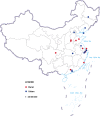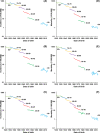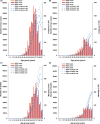Gastric and esophageal cancer in China 2000 to 2030: Recent trends and short-term predictions of the future burden
- PMID: 35148032
- PMCID: PMC9041080
- DOI: 10.1002/cam4.4586
Gastric and esophageal cancer in China 2000 to 2030: Recent trends and short-term predictions of the future burden
Abstract
Background: Gastric and esophageal cancer (GEC) have made a great contribution to the cancer burden in China. This study aims to report GEC incidence and mortality trends in 2000-2015 and their predictions to 2030.
Methods: We collected GEC data from 22 cancer registries for Joinpoint temporal trend analysis between 2000 and 2015 and average annual percent change was calculated. Based on the historical changes, combined with the 2015 GEC national incidence and mortality rate, the rate from 2016 to 2030 was predicted grouped by sex and age. The crude rate, standardized rate, and cumulative rate were calculated. The number of cases were obtained by multiplying the United Nations' World Population Prospects and the predicted rate of corresponding years. Attribution changes between 2015 and 2030 were apportioned into demographics and risk factors.
Results: There were decreasing trends of age-standardized incidence rate world (ASIRW) and age-standardized mortality rate world (ASMRW) during 2000-2015 in China (p < 0.05), the decline was more significant for the age group of 40-49 years in men and the age group of 50-59 years in women. It was predicted that in 2030, about 549,724 new cases and 394,576 deaths of GEC would occur in China. Compared with 2015, the numbers of new GEC cases and deaths in 2030 decreased by 15.24% and 17.62%, respectively. From 2020 to 2030, GEC ASIRW and ASMRW were predicted to decline from 24.98 to 17.47 and from 17.41 to 11.82 per 100,000, respectively. The number of new cases decreased by about 15.24% with changing demographic (44.48%) and risk (-59.72%) and the number of deaths decreased by about 17.62% with changing demographic (47.18%) and risk (-64.80%).
Conclusions: Although GEC incidence and mortality rates showed downward trends, the disease burden remains heavy in China. The current prevention and control strategy are effective which need to be carried on.
Keywords: China; esophageal cancer; gastric cancer; prediction; temporal trends.
© 2022 The Authors. Cancer Medicine published by John Wiley & Sons Ltd.
Conflict of interest statement
The authors have no conflict of interest.
Figures



References
-
- Sung H, Ferlay J, Siegel RL, et al. Global cancer statistics 2020: GLOBOCAN estimates of incidence and mortality worldwide for 36 cancers in 185 countries. CA Cancer J Clin. 2021;71:209‐249. - PubMed
-
- Ferlay J, Ervik M, Lam F, Colombet M, Mery L, Piñeros M, et al. Global Cancer Observatory: Cancer Today. : International Agency for Research on Cancer; 2020. Cited 3 Apr 2021. Available at https://gco.iarc.fr/today.
-
- Zeng H, Chen W, Zheng R, et al. Changing cancer survival in China during 2003‐15: a pooled analysis of 17 population‐based cancer registries. Lancet Glob Health. 2018;6:e555‐e567. - PubMed
Publication types
MeSH terms
LinkOut - more resources
Full Text Sources
Medical

